SST in Costa Rica: Discomoviles and Sound Systems
by David Katz
Spending a month in Costa Rica was inspiring and instructive. It is a stunningly beautiful place with unique subcultures that have gradually evolved in different parts of the country for different reasons. The music scene is incredibly varied, and reggae has long been a part of it, especially in the Caribbean province of Limón. Yet, regarding the country’s popular music cultures and the sonic street technologies that help bring music to the people, reggae is only part of the picture, a vibrant element that remains somewhat underground.
In general, when considering the specificities of the sonic street technologies of contemporary Costa Rica, we must contemplate various historical, cultural, and social factors, as well as matters of topography. This small Central American nation is home to about five million people, almost half of which live in the broader metropolitan area of the capital, San Jose; the nation is bordered by Panama to the south and Nicaragua to the north, with the Pacific Ocean to the west and the Caribbean Sea to the east, the coasts divided by steep mountain ranges and dense tropical forests and jungles, all of which have contributed to the distinctive musical cultures that evolved in different regions over time. Patterns of migration have also yielded idiosyncratic musical elements, most notably through the arrival of African Jamaicans and other black English-speaking islanders who settled along Costa Rica’s Caribbean coast in the late 19th Century, as well as more recent migrants from various Latin American nations, many of whom reached Costa Rica after fleeing repressive regimes in their homelands.
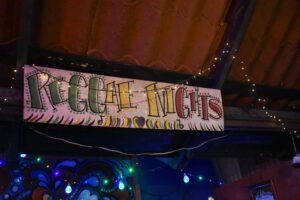
A reggae venue in the town of Arenal in the Central Valley. Image (c) David Katz.
During the long colonial phase that began when the Spanish arrived 1502 and which ended in 1821 when independence was granted to all of Central America, Costa Rica remained a neglected backwater accorded little significance, in part because it had few obvious extractive resources, the sparse and disparate indigenous population less susceptible to forced labour than in other territories of the Spanish Empire; the Spanish imported slaves from west and central Africa, until slavery was abolished in 1823. Newfound wealth was subsequently obtained by the mestizo elite through the cultivation and exportation of coffee, which played a huge role in the modernisation of the newly independent country, and to sustain the growth of this important commodity, between 1870 and 1890, thousands of Jamaicans travelled to Costa Rica to build a railroad line that ran from San Jose to Puerto Limón on the Caribbean coast; smaller numbers came from Barbados, Trinidad and Tobago, and elsewhere, along with Chinese, Lebanese and others. In tandem with the building of the railroad came the establishment of banana plantations, mostly owned by the US-based United Fruit Company, the plantation workers typically Jamaican and Barbadian immigrants who were paid next to nothing for their toil; Marcus Garvey arrived in 1910 to work as a timekeeper on one such plantation, the injustices he witnessed spurring him to embrace political activism, launching The Nation newspaper in Limón. The black populace of Costa Rica then had few tangible rights and were prohibited from living and working outside of Limón province; they were not granted citizenship until 1948, regardless of whether they were born in Costa Rica. Nevertheless, these communities of transplanted black English-speaking Caribbean islanders were responsible for the emergence of a unique local creole language known as Mekatelyu, and the widespread popularity of calypso in the coastal communities south of Limón.
The first half of the 20th Century was generally a time of turbulence for Costa Rica. Military dictator Federico Granados seized power in 1917 and was overthrown in 1919; 100,000 workers staged the Great Banana Strike in 1934 to protest the United Fruit Company’s exploitative practices. Then, in 1948, a disputed election brought a 44-day civil war that left 2,000 dead, leading to the permanent abolishment of the military. Costa Rica has since become a stable democracy, free of the endemic violence that has blighted much of Latin America, although rising levels of crime and violence linked to the international drugs trade have been increasingly problematic in recent years, most notably in Puerto Limón.
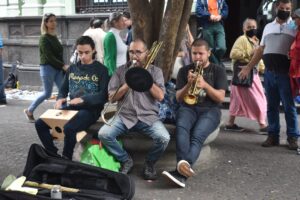
Street band playing Jamaican classic theme Rockford Rock in San Jose. Image (c) David Katz.
To better understand Costa Rica’s contemporary sonic street technologies, we must also consider that its music industry was smaller and less developed than those of larger Latin American nations such as Colombia, Mexico, Cuba, and Peru. During the late 1940s and early 1950s, the first vinyl records released in Costa Rica were mostly local pressings of popular music recorded elsewhere, such as Cuban son and bolero, merengue (which began in the Dominican Republic, and which reached Costa Rica via artists from Venezuela, Colombia, Peru, and Argentina), plus overseas pop music from the UK and USA, much of which had a Latinesque flavour. One of the first Costa Rican acts to be recorded in the country was Trio Los Ticos, a folkloric group; cumbia from Colombia, Panama and other territories became the rage in Costa Rica in the 1960s and 70s, leading to the emergence of popular local acts bringing cumbia into their repertoire, such as Alfa 7, and there were thriving Costa Rican Latin rock scenes, both in San Jose and Limón. Imported reggae became an important feature of the Costa Rican soundscape after cruise ships began travelling to Limón from Jamaica and other Caribbean territories during the 1970s and 80s; cruise ship staff would bring vinyl records to trade with local DJs, just as sailors had brought American rhythm and blues records to sound system operators in Jamaica. Other local hybrids subsequently emerged in Costa Rica, such as a popular dance style known as ‘Chiqui-Chiqui’, which merged the ghostly riffs of reggae rhythm guitar with Pan-Latin and African pop styles; punk, heavy metal and 2Tone ska have also been popular since the 1980s and 90s. Most importantly, the underground hip-hop scene took off in the 1990s as well, just as the local reggae scene mushroomed; dancehall and reggaeton subsequently blossomed, especially in Limón.
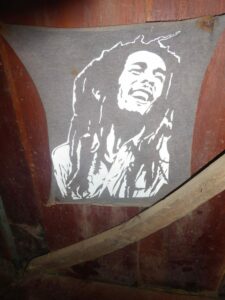
An image of Marley in an art and craft shop. Image (c) David Katz.
Costa Rica’s most prevalent sonic street technology has taken the form of the discomovil, or mobile discoteque, which has been an important part of the nation’s popular culture since the late 1970s; unlike in the larger and more prosperous Latin American territories that established thriving music industries by the 1950s, such as Brazil, Colombia and Mexico, Costa Rica’s sonic street technologies were not in much evidence until the late 1970s and early 1980s, when the nation experienced an economic upturn. The first Costa Rican discomovil was reportedly founded in San Jose in 1978 by local entrepreneur Fernando Malavasi; since he transported his equipment in a large Ford Econoline van he purchased in Panama, he named his discomovil Discovan.
In addition to providing powerful amplifiers, speakers, turntables, and vinyl records, the discomoviles of Costa Rica had an important difference in that they also typically supplied sophisticated coloured lighting to help generate an ambiance, and some also provided dry ice and other visual effects. And as was the case with the original radiolas of northeast Brazil that pre-dated the region’s local reggae craze, the discomoviles of Costa Rica always played a range of pan-Latin dance music, including bolero, merengue, cumbia, and some salsa, as well as foreign pop; in Limón, the focus was more on reggae, soca, funk, soul, hip-hop and Latin styles.
In contrast to the picos of Colombia and the sonidos of Mexico, Costa Rica’s discomoviles have largely remained commercial affairs that simply provide sound equipment and pre-recorded music for hire, often to be set up at private events held at residential homes, schools or hotels, as well as at public events held at music venues, at which an entry fee would be paid; some private customers and venue owners chose to book discomoviles rather than live bands, since hiring a discomovil was often more economically viable, and its DJs could play for a longer duration for a lower fee.
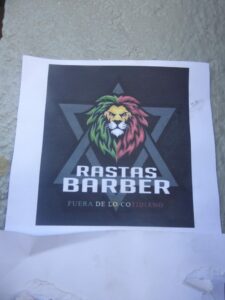
Rastas Barber sign showing influence of Jamiac and Rastafari culture in Costa Rica. Image (c) David Katz.
Most Costa Rican discomoviles have not opted to use custom-built speaker boxes, and unlike the reggae sound systems of Jamaica and the Jamaican diaspora, the discomoviles of Costa Rica do not use pre-amps, do not opt for much real-time manipulative equalisation, and they do not have toasters on the microphone, although many employ someone on the microphone who will offer brief interjections to spur the dancers on.
Several early discomoviles enjoyed symbiotic relationships with local radio stations. For instance, Discovan established a successful partnership with Radio Uno, while their chief competitor, Radio Juvenil, sponsored rival concern Disco Juvenil shortly after the launch of Discovan. During the heyday of the 1980s and 90s, these discomoviles and others such as Furia y Correcaminos, Discomovil 2001 and Discomovil Casablanca were so popular that they could dispatch various team members to play at three or four different events at the same time, similar to the tactics employed by the classic Jamaican sound systems of the 1950s and 60s, such as Sir Coxsone’s Downbeat or Tom the Great Sebastian, which had more than one set of sound equipment and affiliated selectors and operators that they could deploy simultaneously.
San Jose was the epicentre of the discomoviles universe, but there were also important discomoviles scenes in other parts of the country, most especially in Limón, where one called Tiger, based in the peripheral Cieneguita district, mostly played reggae and ska, as well as a touch of soca and calypso.
Since the 2000s, the prevalence of the discomoviles has waned, replaced in part by the rise of DJ crews such as the Reggae Night Crew with the esteemed DJ Acon and DJ Cole, and the Reggae World Crew and the Platinum Crew, who focus on dancehall and reggaeton; typically playing on house PAs, individual DJs and collective DJ crews have become major stars in their own right, using social media to boost their profiles based on individual dress sense and style, without the need to lug the hefty equipment of old. Nevertheless, discomoviles such as Super Disco, Discomovil Costa Rica and Discomovil Zona Caliente remain active.
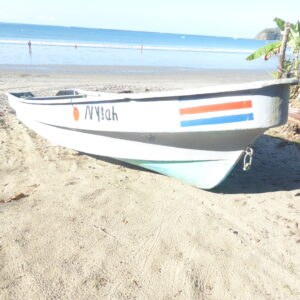
A boat in a fishing village with a Rasta-inspired name. Image (c) David Katz.
Two exceptions to the typical Costa Rican disomoviles setup have emerged in the form of a foundation sound system called The Aces, based in San Jose, and Wolaba Youth sound system, based in the town of Puerto Viejo de Talamanca on the Caribbean coast (a Puerto Viejo techno set called Old Port Sound System is currently inactive). The Aces was formed in 2008 by five friends who had earlier been active in the Costa Rican Rude Boy Union, an informal movement based on a shared love of 2Tone and ska that worked to better the lives of the less fortunate, including the elderly and orphanage residents. Their sound system began with two speakers, one turntable and a hired amplifier, and after building a steady following, they re-built the sound in 2023 with massive handmade speaker boxes that they painted themselves. Co-founder Marco Villa-Lobos Urena, alias Docta Rhythm Selecta, explained that they are unique in Costa Rica as the only foundation sound system that plays exclusively original Jamaican ska, rock steady and early reggae vinyl, typically released no later than 1969. The sound, which plays out frequently, was the reigning champion of a pan-Latin American sound clash, and has hosted likeminded visiting sound systems, such as Fuego Negro from Bogota and Bovver Attack from Mexico City.
Wolaba Youth sound system was founded in 2020 by Dario Obon Menendez, alias DJ Garf, who was born in Spain of part-Moroccan heritage, and who has lived in Costa Rica since the age of seven. After being mentored for ten years by local reggae and dancehall DJs, including DJ Cole, Menendez launched his sound system in Puerto Viejo, acquiring two second-hand speaker stacks and an amplifier in Cartago, as part of a youth project in which locals are taught to surf, as well as how to DJ, in an effort to steer them away from crime. It began as a reggae and dancehall sound system but has more recently featured Afrobeats, which Menendez claims to have introduced to Costa Rica; he tried to introduce the culture of exclusive dub plates to Costa Rica without success. Furthermore, following the birth of his daughter, Menendez has struggled to maintain both the sound system and the youth project, and currently plays out more frequently as a DJ for hire. Nevertheless, the sound system has not been abandoned and is merely on the back burner for now.
It is resoundingly clear that Costa Rica’s sonic street technologies have been a resonant feature of its music scene for several decades; to further unpack its specificities and the meanings that can be ascribed to its evolutionary trajectories, we hope to undertake further research, so watch this space.
David Katz is the author of People Funny Boy: The Genius of Lee ‘Scratch’ Perry and Solid Foundation: An Oral History of Reggae. Visit him at www.davidkatzreggae.com
